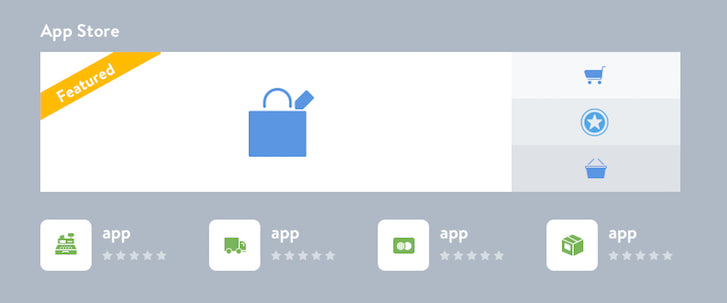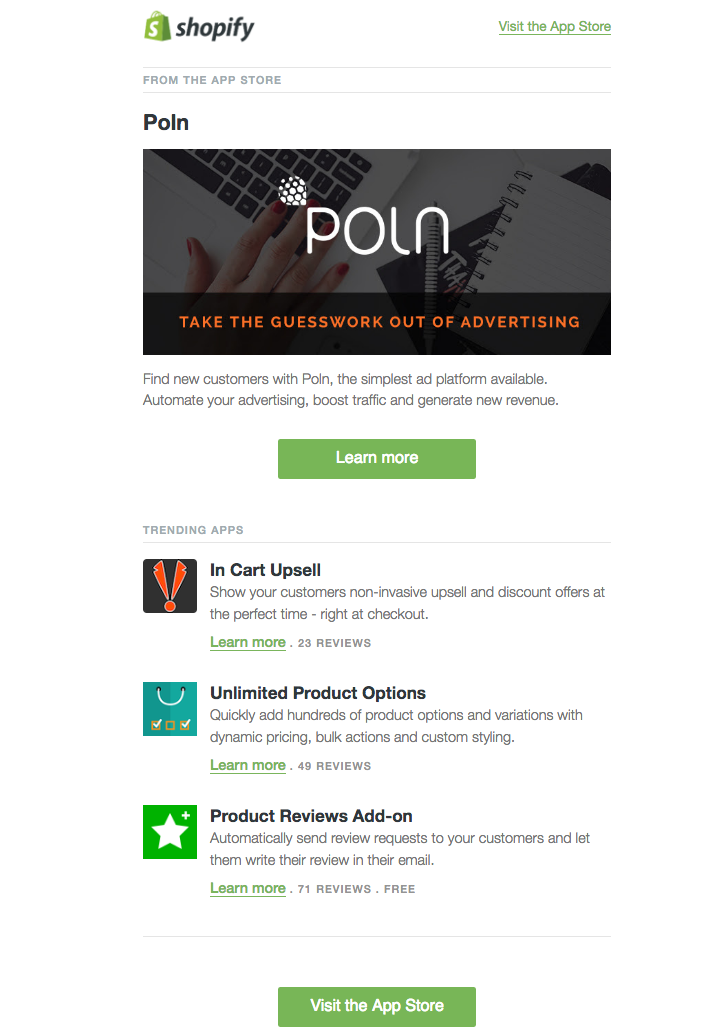The Shopify Apps Team recently made the use of our Billing API mandatory for all apps. While all new apps are required to use our integrated billing solution, we have rolled out these changes to existing apps, and offered a three-month grace period for the developer to comply with these rules.
Our integrated billing solution is better for both merchants and developers. In this article, we’ll outline the benefits of using the Billing API, and layout the promotional campaigns that your app is eligible for once it is adopted.
You might also like: Marketing Your Shopify App: The Details We Overlook
Using the Billing API
There are three different ways for you to bill through your app:
- A one-time app charge is exactly as it sounds — it works perfectly for apps that only need to be charged once. It can also be used with apps that bill quarterly or annually.
- Recurring app charges are billed every 30 days and are included in a merchant’s Shopify invoice.
- Usage based charges allow you to charge a variable monthly fee for any service that you offer. The fees for usage-based charges often vary month to month. Be sure to review the Recurring Application Charge API when implementing usage charges.
Developers and merchants alike will see several benefits from using our Billing API. In our Charging for your App doc, we highlight three reasons why it is important for both you and the merchant:
- The two application charge endpoints integrate into your apps easier than other payment systems.
- The charges appear directly on your user's Shopify invoice — no credit cards or third parties needed.
- You automatically receive your 80 per cent revenue share with Shopify, and Shopify's 20 per cent is remitted at the same time.
The second bullet point is often overlooked and its importance cannot be stressed enough. We need to consider it from the perspective of a merchant.
You might also like: 8 Merchant-Driven Ideas For Your Next Shopify App
Why the Billing API is important for merchants
There are more Shopify stores with three apps, than zero apps. Think about that. The app ecosystem is stronger than ever, and merchants are looking for the right app to augment their Shopify store. The average number of apps that a merchant installs is just over four. If all the installed apps use their own billing system, the merchant is looking at five different invoices (four from apps + the Shopify invoice) for their online store. This, clearly, isn’t a great experience for the merchant.
We receive feedback from merchants asking for all of their charges to be summarized onto a single invoice. This billing solution would allow the merchant to manage the costs of their store and monitor the services that they are paying for simultaneously. It is efficient, clear, and simple for the merchant, and we are moving in this direction.
Why the Billing API is important for developers
If you offer a free trial period, or use a freemium model for your app, you likely monitor the conversion rate and try to get it to 100 per cent. You want to make it as simple as possible for a merchant to make the decision to pay for your app. Since Shopify already stores a merchant’s credit card number for their monthly invoice, accepting a charge for an app through our integrated billing solution is extremely simple.
As an app developer, you no longer need to worry about creating the easiest checkout flow, or saving credit card data. You don’t have to deal with credit card processing fees or chase after merchants because their credit card failed. Let us take care of that — you focus on creating the best value for your customers.
Mike Potter from Rewind recently switched to our integrated billing solution, which has already paid immediate dividends.
“It’s looking very promising. Our conversion rate was about 50 per cent, and it’s looking more like 80 per cent with Shopify Billing, and we expect that to go higher. We’re looking forward to not having to save credit card data and worry about dunning charges for those customers. It’s a real pain managing billing, and we’re happy to let Shopify take care of that aspect of our business.”
Promotional content and marketing
The Shopify Apps Team only promotes apps that provide the most value to our merchants. In order to be eligible for Shopify promotion, you must use our Billing API. The following four methods are used by the Shopify Apps Team to promote apps to our merchants.
1. App banner
There are several high-visibility areas where we recommend apps to merchants. The carousel at the top of the Shopify App Store is a great place to be featured. The banner is highly visible to existing merchants who are searching for new apps, as well as non-Shopify merchants who want to learn more about our marketplace. In order to be considered, be sure to upload an app banner from your Partner Dashboard!
2. App newsletter
Shopify distributes a monthly newsletter to all merchants, highlighting at least four apps that are either new, trending, or important for any business. We are continuing to expand this newsletter to promote the best apps for merchants. Eligibility to be part of the monthly newsletter starts with using Shopify’s Billing API.
3. Shopify Support Advisor team
Our 500+ Shopify Support Advisor team receives thousands of inquiries on a daily basis from our merchants. They are the front line of support between Shopify and a merchant. Most app developers overlook our Support Advisor team as a valuable marketing resource that can promote and encourage merchants to install apps. The team is very effective at finding the best apps to address a merchant’s specific needs.
The Shopify Apps Team regularly identifies and educates our Support Advisors on the most exciting and useful apps. We carefully consider the individual apps that are included in each category and have seen tremendous success with the program.
4. Apps discovery
The merchant’s admin portal has high visibility and is an excellent promotional source to increase your number of app installs. Shopify algorithmically identifies and recommends apps directly in the merchant’s admin portal, by analyzing the store’s needs and history. We filter on several criteria, including shop industry, GMV, sales history, and related apps that similar stores have installed. These ‘smarter’ recommendations are targeted, and are very effective with high install and conversion rates.
Complications with existing merchants
Once you’ve decided to use Shopify’s integrated billing solution, there remains the issue of your existing merchants that are already paying for your app. We understand that moving potentially hundreds or thousands of merchants can be a daunting ordeal.
That’s why we’ve left the implementation strategy up to you. While new merchants that install your app must be directed through Shopify’s integrated billing solution, existing merchants may continue with your current billing solution. However, as per our Partner Terms and Agreement, you are still obligated to remit 20 per cent to Shopify.
Summarizing the importance
There are several reasons why implementing Shopify’s Billing API is important to the success of your app. Merchants do not need to manage another invoice as part of their online store, and app developers do not need to worry about credit card issues. This also translates to an increased conversion rate from trial to paid, or free to paid for freemium models. Your app is also eligible for promotion through the Apps landing page, newsletters, our Support Advisor team, and within the merchant admin portal.
With our integrated billing solution, merchants have a complete summary of the apps that they use as part of their monthly Shopify invoice. As Shopify’s app ecosystem continues to grow, developing the best app with the tightest integration cannot be stressed enough. The better you integrate your app with Shopify, the more likely you will be featured and recommended!
In order to make development as easy as possible, check out this billing tutorial!
You might also like: How to Improve Your Shopify App's Onboarding Flow
Want to learn more about building apps for Shopify? Check out our comprehensive list of articles on Shopify App Development and the Shopify API.
Read more
- Shopify’s Billing API in GraphQL: What App Developers Need to Know
- API Deprecation at Shopify: 2021-04 Edition
- API Deprecation at Shopify: 2021-07 Edition
- Using the Shopify API to Credit Merchants for App Charges
- API Deprecation at Shopify: 2022-01 Edition
- Build Unique Customer Experiences Using Shopify's API
- Free Webinar] Building Commerce into Mobile Apps with Shopify's Android Buy SDK
- Developer Digest: Nov. 1, 2018
- We’re Expanding Shopify’s API So You Can Build Bigger & Better

